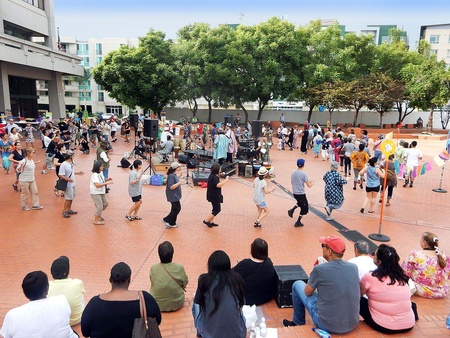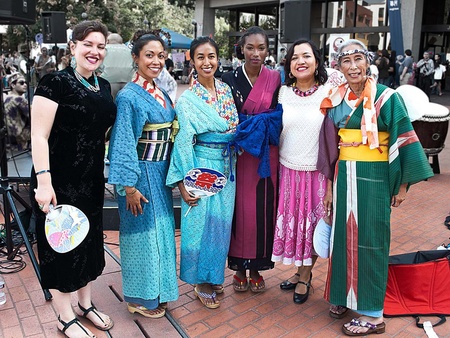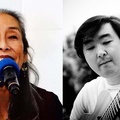FandangObon is a project that brings together the Japanese, Mexican, and African-American communities into one circle to share participatory music and dance traditions in order to celebrate mother earth. During the year, we do a series of workshops around Southern California to expose communities to different cultural spaces, share practices, and explore traditional expressions about the environment. These activities culminate in mid-October, with a large celebration at the JACCC Noguchi Plaza.
The crazy idea of bringing Fandango and Obon together began in 2012, when Quetzal Flores invited me to a Fandango class that he and his partner, Martha Gonzalez were teaching at Plaza de la Raza in Lincoln Heights. Quetzal is the founder and musical director of the Grammy winning Chicano rock band, QUETZAL. Quetzal is also a lover of Fandango, a community celebration of participatory music and dance from Veracruz, Mexico, which draws from Mexican, Indigenous, and African roots. He along with Gonzalez have been instrumental in spreading the practice of Fandango throughout Mexicano/Latino communities in the US.
When I entered the class at Plaza de la Raza, a group of about 20 people of all ages were standing in a circle playing small guitars, called jaranas. Quetzal immediately put a jarana in my hands and said, “play!” I shook my head, but he ignored my protest and led me into the circle. My fingers stumbled but I sort of began to get the chords. I sounded lousy, but with everyone playing, who could tell? The criteria for success was based on how deeply one participated! This later became the foundation for what was built.
There was a wooden platform, or tarima, in the middle of the circle where participants stomped out percussive rhythms. The circle around the platform reminded me of Obon, except in Obon, the musicians are on the platform or yagura and people dance around it. Once class was over I asked Quetzal, “What if we combined Fandango with Obon? He said, “Yes!”
I began creating Obon song/dances in the mid-eighties, when Rev. Mas Kodani of Senshin Buddhist Temple recruited me to write an Obon song in English so that younger people would understand why they were dancing. I was one of those people. As a contemporary songwriter, I also didn’t know much about Obon music, so creating “Yuiyo” was a scary, learning-by-doing process. But soon I got into the beauty of this art form that pulled hundreds of people, young and old, to experience oneness by dancing in a circle.
Since Rev. Kodani has been my guide to Obon songmaking, I decided Quetzal and Martha should also meet him and explore what a collaborative Fandango and Obon song might sound like. He challenged us stating; “The song should not be a fusion. Each form has to stay true to itself. It has to be a conversation.” Thus “Bambutsu – no tsunagari” was born which means “all things connected.” Then the dance was created with head dance teacher, Elaine Fukumoto, Martha Gonzalez, and myself.
Once we had our song we had to find a way to bring the Mexican and Japanese communities together to dance “Bambutsu.” Workshops were needed for our communities to meet and learn each other’s dances for the final big gathering. The JACCC was the perfect place, with the circle in the plaza that Isamu Noguchi designed for Obon. Geographically it was also close to the bridge that connects Boyle Heights with Little Tokyo. Leslie Ito at JACCC said, “Yes!” and became a partner in the project. For the first postcard for the event, Lluvia Higuerra, the graphic designer, shoved the two words together and it became “FandangObon.” Yes!
The first year was so successful and fun, we had to do it again. “Bambutsu” became a kind of hit and was brought into local Obon Festivals—the first Obon song in English, Japanese, and…Spanish! For 2014, we created an environmental festival as part of FandangObon. Climate Change is something everyone faces and we people of color have wisdom from caring for the earth to share. We approached Sustainable Little Tokyo and they said “Yes!” In 2014 we invited the African American community into the circle. A new song, “Omiye” created with Nigerian drummer Najite, was a call for water in the Yoruban tradition. Five days after we danced, it rained.
We just completed FandangObon 2015 and the circle is growing. Are we creating a new Angeleno tradition? I don’t know. What I do know is: In an age where we observe the world through our various rectangular devices, to step into the circle of FandangObon is a potent communal act. In this circle we reclaim our power, our creativity. We make music with our own hands, our own voices. We circle the earth with our own feet and remember we belong to it. In this circle everyone is equal, everyone is seen, everyone has a place to be. In this circle we are intergenerational, pluralistic, interdisciplinary. In this circle we are weaving relationships that can change the world around us and beneath us.
Thank you Quetzal, for your first “Yes!” And, for all the other “Yeses” that keep us spinning. And if you haven’t done it yet, I invite you to join the circle and taste FandangObon for yourself.
Bambutsu…all things connected!
© 2016 Nobuko Miyamoto







